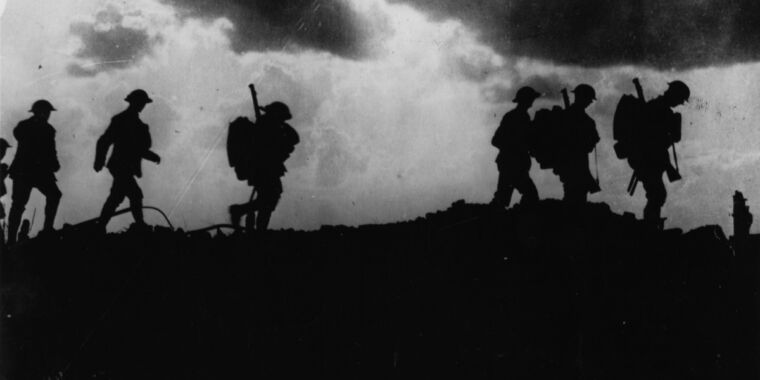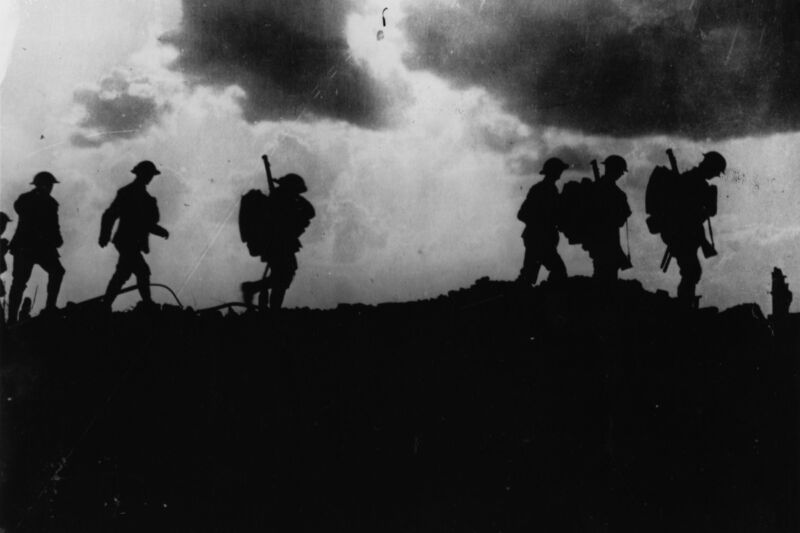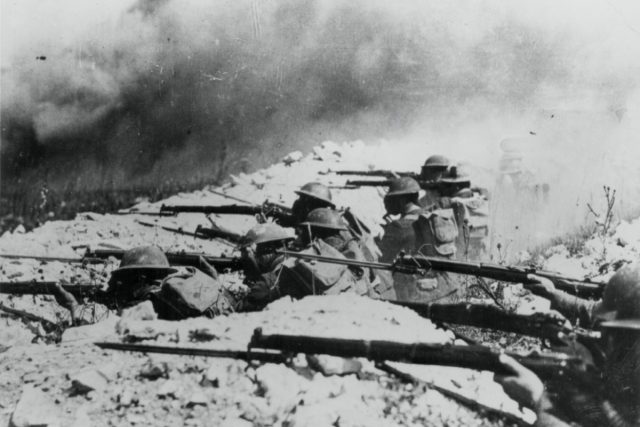
Miracle worker —
Ars chats with author and historian Lindsey Fitzharris about her new book, The Facemaker.
Jennifer Ouellette
–

Enlarge / British troops moving to the trenches east of Ypres in October 1917. A new book by historian Lindsey Fitzharris explores the stories of those soldiers who suffered severe facial injuries, and the pioneering surgeon who rebuilt their faces: Harold Gillies.
Hulton Archive/Getty Images
In August 1917, a World War I British soldier named John Glubb was hit in the face by a shell. He recalled blood pouring out in “torrents” and feeling something akin to a chicken bone moving around his left cheek. It turned out to be half of his jaw, broken off by the impact.
Glubb wasn’t the only unfortunate WWI soldier to suffer a disfiguring facial injury. Shells filled with shrapnel were designed to inflict as much damage as possible, and the need to peer over the parapets of trenches to assess the battlefield or fire a shot meant a greater risk of getting hit in the face by bits of flying metal. Unlike losing a limb, these soldiers faced great social and professional stigmas when they returned home from the front because of their disfigurement. They were usually reduced to taking night shifts and relegated to special blue benches when out in public—a warning to others to avert their eyes.
Fortunately for these men, a New Zealand-born surgeon named Harold Gillies devoted his life to developing innovative techniques for reconstructing faces after witnessing the carnage firsthand during his service at the front. Once home, he set up a special ward for soldiers with facial wounds at the Cambridge Military Hospital in Aldershot, eventually convincing his superiors that a dedicated hospital was warranted. He’s often referred to as the “father of plastic surgery” because of his pioneering work at The Queen’s Hospital (later renamed Queen Mary’s Hospital) at Frognal House in Sidcup.
Gillies is a key figure in a new book by author and medical historian Lindsey Fitzharris, entitled The Facemaker: A Visionary Surgeon’s Battle to Mend the Disfigured Soldiers of World War I. A noted science communicator with a large Twitter following and a fondness for the medically macabre, Fitzharris published a biography of surgical pioneer Joseph Lister, The Butchering Art, in 2017—a great, if occasionally grisly, read.
Her work soon caught the attention of the Smithsonian Channel, who tapped Fitzharris to host their 2020 documentary series revisiting infamous historical cold cases, The Curious Life and Death Of…. Fitzharris usually has several book ideas simmering on the back burner at any given time. For instance, she has a children’s book coming out next year illustrated by her husband, cartoonist/caricaturist Adrian Teal, and is already working on a third book about a 19th-century surgeon named Joseph Bell, who inspired Sir Arthur Conan Doyle’s Sherlock Holmes.
The Facemaker was not her first choice for a follow-up to The Butchering Art, since she wasn’t that knowledgeable about World War I. But her publisher loved the story of Gillies, so Fitzharris gave herself a crash course in the history of that period. “The Butchering Art is hyper-focused on one man, Joseph Lister, who applied germ theory to medical practice,” Fitzharris told Ars. “This is a book not about one man, but many men. It’s about Harold Gillies, the pioneering surgeon who rebuilt soldier’s faces during the First World War, but it’s also about these disfigured men. I hope that their voices really shine through in the narrative.”
Ars spoke with Fitzharris to learn more.
(Warning: Some graphic facial reconstruction photos and descriptions follow.)

Enlarge / US Army trainees in trenches on the Western Front during World War I, France, 1918. The need to peer over the parapets resulted in a dramatic rise in facial injuries from shrapnel, often quite disfiguring.
Archive Photos/Getty Images
Ars Technica: This is such a massive topic. How did you narrow the focus so that the scope was manageable?
Lindsey Fitzharris: It’s true, it was a much more complicated story. I think that’s why it took me five years to write, just coming to grips with the scale of World War I, with military medicine at that time, with all of these complicated advances. One of the challenges with World War I is there is so much material: so many diaries and letters by the soldiers writing about their experiences. Someone asked me what the difference is between academic history and the commercial history that I write. A lot of what I do now is discard information. I’m absorbing a lot in my research, but I’m pushing that away because I don’t want to overwhelm the reader. I want to find the pulse of the story.
I knew I wanted to drop the reader into the trenches right from the beginning. There’s a man named Percy Clair who wrote this beautiful diary that allowed me to tell the story of what it was like to be injured, hit in the face, and lay on the battlefield for quite a long time before you were recovered. I wanted the readers to understand how difficult it was in the first instance just to get off the battlefield, and then to get to Gillies, because Clair was initially sent to the wrong hospital.
There were also complications around accessing patient files in the UK, and what you can and can’t say with regard to a patient’s name. When I’m using a patient’s name in The Facemaker, it’s because that knowledge is public, or Gillies himself had published it at some point. If Gillies published about a certain patient, if I went into the case files and found further information that he hadn’t included, I couldn’t use that information in relation with that person’s name. The Butchering Art didn’t have that complication because it was set in the 19th century. Everything was old enough that we didn’t have to worry about all of that. But a lot of the material for The Facemaker is in copyright. I had to contact Percy Clair’s family members to get permission to quote from his diary to the extent that I did.
